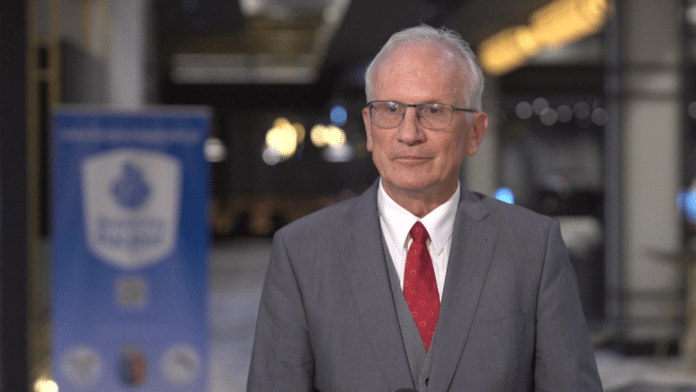Thanks to the high standards developed over the past decades, anesthesiology is today one of the safest fields of medicine. Nevertheless, the problem of peroperative complications is increasing due to the growing number of hospital infections. This significantly worsens the prognosis of patients after surgery. – The three areas where patient safety and treatment optimization could be improved are infections, proper pharmacotherapy, and correct diagnostic imaging – emphasizes anesthesiologist Prof. Janusz Andres. As he highlights, a discussion among experts from different specialties is necessary to help resolve current issues and improve the general safety of hospitalized patients.
– Anesthesia is a field of medicine that is at the forefront of safety. Our standards have resulted in a several hundred-fold decrease in anesthesia-related mortality over the past century. Today, we can say that anesthesia is as safe as aviation – the risk of death from anesthetic reasons is minimal. However, paradoxically, postoperative mortality is increasing. Considering the last 10 years, in Europe, in highly developed countries, the average postoperative mortality has almost quadrupled. Therefore, we need to optimize safety, patient preparation for surgery, intraoperative monitoring, and postoperative procedures to minimize postoperative mortality or complications – says Prof. Janusz Andres, President of the Polish Society of Anesthesiology and Intensive Therapy and President of the Safe Patient Foundation to the Newseria Biznes.
According to statistics from the Supreme Medical Chamber, there are about 7 thousand professionally active anesthesiologists in Poland. Thanks to the standards introduced in the 1960s, this field of medicine has significantly contributed to the decrease in perioperative mortality at the beginning of this century.
– Nobody cares about patient safety under hospital conditions like an anesthesiologist – says Prof. Łukasz Krzych, a specialist in anesthesiology and intensive therapy from the Silesian Heart Diseases Center in Zabrze and the Medical University of Silesia in Katowice. – The patient usually associates the anesthesiologist as the one who will anesthetize him in the operating room. It is they who take responsibility for the patient’s safety from the moment of admission to the hospital to discharge. It’s not just the moment of anesthesia, but also many other elements. The anesthesiologist is, in fact, a doctor of many specialties who needs to know not only the medical procedure itself but also the medications the patient is taking, their risk factors, multi-morbidity, to safely prescribe and perform anesthesia.
Hospital infections are becoming a growing problem. This significantly worsens the prognosis and prospects for patients to return to proper functioning and improve their quality of life after surgery. The situation in this regard is now worse than a decade ago, even in developed countries. In Poland, for at least several years there has been an upward trend in the number of reported hospital infection outbreaks, which are one of the main factors contributing to the development of antibiotic resistance. According to GIS reports (“Health status of the country”) in 2022 there were a record number of cases – over 5.1 thousand outbreaks. The previous year there were 4.43 thousand, much less in 2020 – 2.8 thousand, and in 2019 – only 692. The growing number of hospital infections has also been pointed out by the Supreme Audit Office, which says that hospital infections account for 5 to 10 percent of all hospitalized patients. In Poland, this already accounted for at least 400,000 cases per year.
– The improvement of hospital conditions in the context of generating multidrug-resistant bacterial strains, the transmission of infections between patients – this responds to the requirements of the World Health Organization. This includes hand hygiene, cleanliness in departments, but also the judicious use of antibiotics according to their clinical indications, remembering that these are very potent chemotherapy drugs, which should not be used too often, for too long, and in the right clinical situations – says Prof. Łukasz Krzych.
As the experts point out, in order to increase hospital patient safety in the perioperative period, three main areas need to be improved. In addition to the growing number of hospital infections, these are also diagnostic imaging, which anesthesiologists currently have limited insight into, and the availability of new drugs, the method of administration, and the overall safety of pharmacotherapy.
–The anesthesiologist has several drugs to choose from, and they must be used under control because they cause unconsciousness, induce anesthesia, sometimes affect the heart, raise or lower blood pressure. We need to have drugs that are optimal for a given patient and our monitoring system. These drugs are getting better – we have new sedative drugs, we have new drugs that maintain the circulatory standard and can optimize blood pressure, – Prof. Janusz Andres lists. – These are the three areas where patient safety and treatment optimization can be improved: infections, proper pharmacotherapy, and correct diagnostic imaging.
Since this involves various fields and specialties, there is a need for an interdisciplinary discussion, which would help solve this problem.
– The biggest challenge for the anesthesia community today is to convince other specialties and the entire health care system that we should raise the standards of safety and optimization in the perioperative period. We want to convince other specialties and healthcare managers about remote monitoring of treatment effects and optimize them, says the president of the Polish Society of Anesthesiology and Intensive Therapy. We, of course, also need to introduce new monitoring methods, new, safe medications, and individualize therapy to suit each patient. We have the tools and we are on the right track to improve the quality of medical services.
– The latest data shows that we can effectively and safely carry out procedural sedation, also known as light sedation. We currently have a whole constellation of drugs that allow us to reduce pain, reduce anxiety, sometimes also to induce amnesia associated with performing the procedure itself, but also new short-acting medications that are quickly metabolized, that operate independently of kidney or liver capacity are also coming in. We have such medicines at our disposal, of course adapting a particular drug toe a specific patient – says Prof. Łukasz Krzych.
Doctors also emphasize the necessity for patient education, who should be conscious participants in their own treatment process. In this context, it is also essential for anesthesiologists to properly prepare them for surgeries and reduce their fear of the operation.
– During the anesthesiological visit, we have the role of informing the patient – even if they do not ask – about what will happen, what we plan, what are the potential risks associated with anesthesia and the operation. Anesthesiological clinics, in which the patient is assessed by an anesthesiologist a few weeks before the scheduled surgery, help us a lot in doing this. At that time, the patient is not yet that stressed about the forthcoming procedure, and we have more time for direct communication with them, says the specialist in anesthesia and intensive therapy from the Silesian Heart Disease Center in Zabrze and the Medical University of Katowice. Of course, the body’s stress reaction often cannot be eliminated just by talking, and pharmacological agents come to our aid here, in the form of so-called premedication, colloquially called “stupid Jacek”, or periprocedural sedation or procedural sedation, the aim of which is to alleviate anxiety and stress associated with the medical procedure itself. However, remember that in any procedure, the most critical thing in all this is the patient’s self-awareness.
The safety of patients in the perioperative period and the current challenges of anesthesiology were the main topics of the Interdisciplinary Patient Safety Forum, which took place last week (15-17 September) in Krakow. The event, organized by the Polish Society of Anesthesiology and Intensive Therapy (PTAiIT) and the Safe Patient Foundation, coincided with the World Health Organization’s World Patient Safety Day on September 17. The organizers also drew attention to the fact that last year marked the 12th anniversary of the publication of the Helsinki Declaration on Patient Safety in Anesthesiology, considered the basic document defining safety standards in perioperative medicine.


















